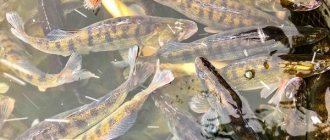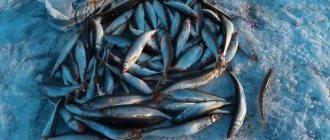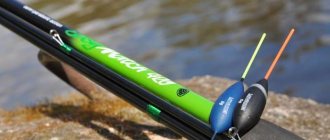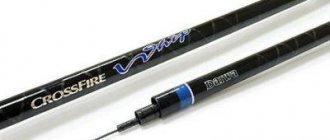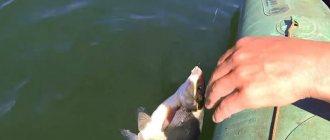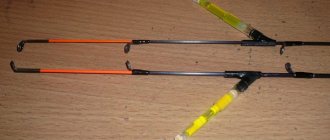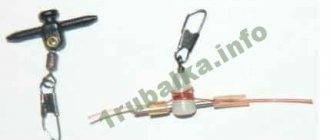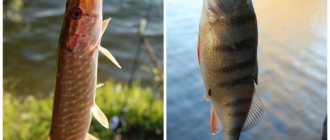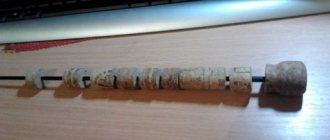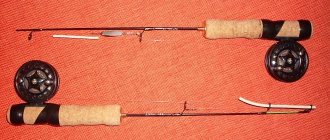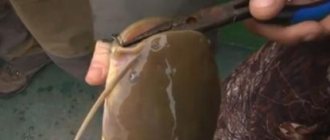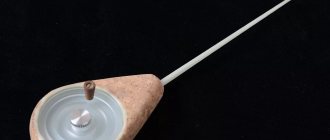Equipping winter fishing rods for pike perch requires some features and nuances, the implementation of which will not give the fanged fish a chance to bypass the bait or make an empty grab. The winter behavior of this predator, tactics and search leave an imprint on the necessary elements of the installation of gear. In this article we will analyze the most popular and working gear for pike perch in winter, equipment options, and features of their use in various conditions.
Winter fishing for pike perch
Before you begin installing fishing rods for winter fishing for pike perch for the first time, it is important to understand that the determining link in the success of hunting for fanged fish is the correct tactics and search for the striped predator in the reservoir. The main thing in winter fishing for this type of fish is to find parking spots or exit points for pike perch. These nuances of predator behavior are discussed in more detail in a special article:
It is a successful search and finding of working points that is the main condition for successful fishing for this fish. In 80% of cases, with successful search activities, even with somewhat incorrect gear, the fisherman is doomed to get bites. Pike perch is greedy and aggressive, periods of complete passivity are rare. In addition to location, the choice of time of day also matters - in some reservoirs, pike perch go out to feed according to a schedule, in others - chaotically and unpredictably. You can also read about all this in the publication at the link given above. Here we will directly analyze the methods of catching pike perch in winter, conventionally assuming that the angler is already familiar with the main points of the correct tactics and search for fanged fish for winter fishing.
Lures for winter fishing with a fishing rod
All baits for catching pike perch in winter can be divided into several groups:
- A classic winter spinner for vertical spinning.
- Rattlin.
- Amphipod.
- Balance.
Equipping a fishing rod with such baits usually gives good results. However, for each case, you should select the most effective option by trial and error. The preferences of fish even in the same body of water can change. And if today pike perch is caught well with a regular vertical spoon, then in a couple of days the amphipod will give better results.
Read: Making amphipods with your own hands
What gear to use to catch pike perch in winter
Depending on the conditions of the reservoir and the preferences of the fisherman, it is possible to use various winter gear for pike perch. Here are the most popular and working fishing methods:
- Winter sheer glitter,
- Vertical ice jig,
- Fishing with a jig with bait (for example, sprat),
- Winter donks for artificial or natural baits,
- Arrangement of pike perch poles (flags, supplies).
A pike-perch winter fishing rod, regardless of the fishing method, must be strong and elastic, since the striped predator is strong and reaches impressive sizes. Weak tackle simply won’t hold up when biting seasoned pike perch. At the same time, the equipment needs to be sensitive enough to effectively control the bait and register a bite. The best winter fishing rods for pike perch detect the most gentle bite, make it possible to make a sharp hook and do not break when fishing for large prey. Next, we’ll look at how to properly equip a winter fishing rod for pike perch.
Tackle for catching pike perch in winter and fishing methods
Actually, to catch pike perch in winter, we use ordinary winter gear, adapted for catching large fanged predators.
- Winter tackle for trolling pike perch;
- Tackle for catching pike perch with jigs, sprat, silicone baits;
- Zherlitsa for zander.
Let's look at each of these methods of catching pike perch in winter in more detail.
Winter trolling of pike perch
Fishing for pike perch in winter is possible using different baits. The most popular are:
Each of these baits has its own range of applications, advantages and limitations.
Catching pike perch in winter with spoons
Winter vertical spinners, along with balancers, are one of the most popular types of fishing. Pike-perch spoons, depending on the geometry, can be either gliding or diving. There is also one that is not similar to these species - the amphipod spinner.
Gliding spoons are used for catching active pike perch, and diving spoons for passive ones. In addition, to improve catchability, sometimes they use baiting the hooks of a spinner with a fry or a piece of fish.
Fishing for pike perch in winter on Bokoplav
The Bokoplav (Osa) spinner is attached in a way that is not quite usual for spinners. Yes, this is not quite an ordinary bait. An amphipod for pike perch works somewhat differently than a balancer or a vertical spoon. See the video below for more details.
Catching pike perch in winter using a balance beam
Balancers for pike perch are no less popular than vertical spinners. Catching pike perch in winter with a balancer, in general, is carried out according to the same principle as with other spoons, taking into account the specifics of the game of this bait.
Fishing for pike perch in winter on rattlin
Rattlins are a lure of the wobbler family. Created for spinning fishing, it is successfully used for fishing in winter. Any predatory fish, including pike perch, can be caught using rattlins. Oddly enough, sometimes when catching a predator, a large bream is also caught on the rattlin. However, this also happens when fishing with other baits.
Rattlins for zander
You can see how to catch pike perch in winter using rattlins in the selection of videos at the bottom of the article.
Winter fishing rod for pike perch
As a fishing rod for trolling pike perch in winter, a winter fishing rod with a fastening for an inertial or inertial-free reel, with a fairly stiff whip and winding rings, can be used.
The whip should provide the confident, hard hook needed to break through the bony mouth of the pike perch. The tip of the whip can be replaceable, following the example of the feeder whip. This will allow you to record even weak bites from pike perch, bass or even perch without nodding.
Catching pike perch in winter with a jig
Catching pike perch in winter with a jig is carried out with the addition of natural or artificial bait.
The role of an artificial attachment on a jig hook can be played by suitable silicone baits - twisters, vibrotails, etc. Edible rubber works well for pike perch in winter. An artificial bait is, as a rule, various silicone baits of a suitable size, including “edible silicone”.
The natural bait is usually frozen or fresh sprat, sprat, various kinds of whitebait, and pieces of fillet of any fish.
Among natural additives, the most popular is sprat. It is believed that due to its specific smell, pike perch like it the most. And there is a reason for this - pike perch has a very highly developed sense of smell.
Pike perch on a jig
When catching pike perch with a jig, the principle of combined equipment is often used - two jigs tied in series or a jig + a hook with a bait.
Jig for pike perch + hook on a leash
Jig for pike perch
A jig for pike perch is a fairly heavy bait that can reach the bottom at great depths in the presence of a current. Instead of a jig, a spinning jig head of suitable weight is often used.
Catching pike perch with a jig can be passive or active.
In the first case, the jig with the nozzle is lowered to the bottom, and the fishing rod is placed on the ice (postavusha). The fisherman only watches the guard and records the bite.
The passive method of catching pike perch with a jig works in the presence of a current, when water flows force the bait to move on its own.
Active fishing for pike perch with a jig is carried out using bait. The fisherman lowers the jig to the bottom, and performs an animation of the bait - rocking the jig, lifting, freezing - various movements that force the pike perch to make a grab.
Unlike a fishing rod for trolling, a fishing rod with a jig for pike perch must be equipped with a nod.
Catching pike perch with a zherlitsa
Catching pike perch in winter with a zherlitsa is often used as an auxiliary passive method. The traps are placed in the place where the pike perch is expected to emerge, and in the meantime it is caught using balance beams, spoons or jigs.
The jig rig for pike perch can be made as in the figure above, or with a leash located above the sinker. This type of installation (with a retractable leash) is preferable when fishing for dead fish or sprat in the presence of a current.
Fishing rod equipment
So, to catch pike perch you will need reliable and strong tackle. The equipment for pike perch is not particularly elegant - it makes no sense to use thin fishing lines. A fanged fish at great depths and in the dark (especially since the best time for fishing is night, dusk or dawn) will not be able to distinguish a thick monofilament in the water). Another important factor is the convenience of the gear. The basis of tactics is a constant search for points. In a day you need to drill dozens of holes and fish them. In addition, the fisherman is forced to move a lot. The working hang of the tackle is long, since you always have to fish at fairly large depths, usually from 5 to 15 meters (usually 7-12). Therefore, the fishing rod should be easily retracted for transition and quickly brought into working condition.
Rod
The choice of a rod for winter tackle for pike perch must be approached with all responsibility. Catching many other types of fish does not require high performance characteristics of a winter whip - it is only involved in guiding and partly in hooking. The pike perch has a very strong bony mouth. To cut through it, a strong and elastic hook is required. A weak whip will simply break; too hard a whip will break the fishing rod rig due to lack of elasticity. The bite of a large pike perch sometimes happens sharply and unexpectedly, from acceleration. The tackle must remain stable. A fishing rod is not required only when fishing with hooks - there the hooking is carried out by the fishing line.
A good option is a special fishing rod for winter trolling. Such carbon fiber winter fishing rods for pike perch (and pike) are obviously made taking into account all the features of fishing. Fiberglass rods are also suitable, they are heavier and cheaper, but it is less convenient to work with them for a long time.
Many anglers make their own equipment for winter fishing for pike perch. As you already understand, the main thing in such a fishing rod is the whip and the rings. The handle and reel seat can be made in any design; a simple wooden stick and electrical tape will do. The main thing is the whip. The whip is purchased at the store. An elastic feeder quivertip or the upper part of a summer spinning rod will also work. Of course, in extreme cases, if there is no opportunity to make or buy good tackle, you can get by with the simplest option - a rough fishing rod with reels. It is inconvenient to work with such gear during active search. Imagine for yourself - every time you go, reel out 10 meters of fishing line onto the fishing rod reel, and then unwind it back. And so dozens (hundreds) of times.
The caliber of the rod depends on the fishing method and the weight of the bait. An experienced fisherman always has a whole set of tackle in his box, pre-configured and matched to the weight of the spoon or balancer. The requirements for fishing rods for winter baits and jigs are the same. Jigs for pike perch are large and heavy, especially for currents.
fishing line
The best fishing line for winter walleye fishing is a good fluorocarbon or fluorocarbon line. Line requirements:
- Diameter 0.25-0.35 mm, depending on the caliber of the tackle.
- Lack of memory.
- Resistant to abrasion and ice damage.
- Low elongation - do not forget about powerful, high-quality hooking.
An excessively soft fishing line at great depths will not allow it to penetrate the mouth of a predator due to its stretchability. Braid and lines are rarely used for pike perch in winter; in the cold they become tanned and stick to the reel. The best solution is high-quality winter fluorocarbon monofilament. Leashes are not used for pike perch; the bait is attached directly to the fishing line with a knot, loop or through a fastener.
Nod
There are many varieties of nods for winter fishing rods for pike perch; each angler uses something different. You need to understand that the fanged one, especially in winter, prefers low-amplitude, smooth play with long pauses. Therefore, the gear guard should not perform parasitic spring vibrations. The fall of the bait must be smoothly extinguished at the lowest point so that it does not bounce, but slowly fades in its downward movement. Previously, metal spring nods or lavsan, plastic strips from PET bottles were used on fishing rods. Now the best option is to use a frost-resistant silicone tube. Such a nod does not dull in the cold. Silicone nods can be found at a fishing store. If you have the required length of tube, such a nod for pike perch can be done with your own hands in a couple of minutes.
What to catch pike perch in winter
Despite its aggressiveness, the fanged fish cannot compete with pike and feed on large fish. Although the striped one has a huge toothy mouth, its throat is narrow. Pike perch prefers to hunt for relatively small, narrow-bodied fish. Gudgeon, loach, goby, bleak, verkhovka, minnow, dace, sprat are the basis of the diet (depending on the reservoir). Accordingly, when fishing with live bait or girders, as well as as dead fish, it is better to use these breeds.
Among artificial baits, fishing for pike perch in winter using spoons, balancers, amphipods and rattlins stands out. Interesting solutions such as voucher (column), bulldozer, and mormobles are successfully used. No one has canceled special heavy pike-perch jigs for replanting sprat or pieces of fish. Read more about winter pike perch baits. A small number of anglers successfully catch pike perch in winter using edible rubber and silicone using a vertical jig. The baits used are vibrotails, twisters, slugs on a jig head, a Cheburashka sinker or a lead rig. Pike-perch does not cut the line on the tackle like pike, so a leash is not used. Lures, depending on the equipment, are attached directly to the fishing line.
Reels
Ideally, a winter fishing rod for pike perch is equipped with a reel. Fishing is done at depth, the fisherman needs to constantly move, which means he often winds and unwinds the tackle. A reel for winter fishing for pike perch is essential. You can use the following options:
- Cheap plastic ice fishing reels with an open spool. You should choose open reels with a diameter of 50 mm, preferably with a release button. In general, it’s great if such a simple design has a friction clutch.
- Good winter reels for trolling. Such solutions are already more expensive, but this is exactly what is needed. Such devices are specially adapted for winter sheer trolling: there is a friction brake (which allows you to use thinner fishing lines and use American-style fishing with a rod), the drum is large and does not freeze when wet.
- Small spinning reels or multipliers. Very comfortable too. But due to their high cost, they are not very popular.
Fishing rods for jigs
Let's assume that the angler has already tried fishing with a jig, using standard fishing rods on a riser, and decided to take the active game more seriously. To do this, we set up that we will need several tackles, about a dozen, pre-balanced at home - for different weights of jigs, respectively, with selected nods and line thicknesses. Therefore, you need to buy 5-10 fishing rods at once. You should pay attention to special jig fishing rods - lightweight winter balalaikas. Fishing stores and online stores now sell everything you need for this. Specialized sports winter fishing rods for jigs are the best option. Such fishing rods are a little more expensive (100-300 rubles), however, they are worth it. Such fishing rods were originally designed for game fishing with jigs. However, such gear is not always easy to obtain. Sometimes you need to do some serious shopping or surf the Internet in search of the right option.
Yaroslavl balalaika, US-4 Tri Kita and HFB-22
The Master Sportivnaya winter jig fishing rod was developed by the famous sports fisherman Evgeny Chabutkin from Yaroslavl. The tackle is popular among athletes and amateurs. Light weight (11 grams) and size (thickness 6 mm), simplicity. There are no special bells and whistles - the design is simply made exactly as needed for jig fishing. The fishing rod has been verified by the creator’s many years of competition experience. The cost of the product is about 300 rubles. Cheaper analogues - Three whales of the US-4 Sportivnaya and Chinese replicas (for example, Rosy Down or HFB-22). These products are no worse than the Yaroslavl ancestor, but many times cheaper.
Ivanovo balalaika
A similar product is a sports balalaika from Mastiv for 100 rubles. The designs and dimensions are similar. The body is made of hard foam. Thus, the coil is built into a foam casing. This is both an advantage and a disadvantage. Light weight and “warmth” of the material for the hands against fragility. This fishing rod requires careful handling.
killer whale
The Killer Fishing Rod from Crazy Brothers is also specially designed for game jig fishing. The special curve of the body may be convenient for anglers. Light weight, smooth rotation of the reel, overall lightness and simplicity.
These three balalaikas are considered the best winter fishing rods for jig fishing. These tackles are also suitable for reelless fishing without a nod, if you replace the whip with a thin carbon one. The light weight of the tackle as a whole allows you to feel bites in your hand and give the game the desired high-frequency character. You need to understand that it is better not to leave such fishing rods unattended in the riser hole - even a small roach will pull such a light structure under the water.
Spinning and ice jig
The most popular method, of course, is winter lure or vertical jig. There are special requirements for a fishing rod for this method of fishing, as close as possible to those stated above in the article. The main thing is to balance the tackle. The flexibility of the rod, the diameter of the fishing line, the nod and the weight of the bait are selected individually. It’s better to set up a set of different gear in advance so as not to have to deal with installation and dressing on the pond. A winter rod for pike perch for fishing with edible rubber and silicone is selected in exactly the same way, since the technique is practically no different from trolling.
Zherlitsy
The main nuance of rigging a winter bait for pike perch is the use of one single hook. When biting, the fanged one clamps the prey in its mouth, swallowing it a little later. A double or treble hook can prevent a predator from swallowing live bait, but a single hook works well. The reel should have a large supply of fishing line, 20-30 meters. A predator can swim this distance between grasping and swallowing prey, simply by holding the fish in its mouth. If there is not enough fishing line on the fishing reel, the predator, sensing resistance, will most likely spit out the bait.
Winter donks
Donka is convenient to use as a tackle for catching pike perch in the winter on the current. To do this, you can use a regular fishing rod for trolling, only in this case the nod is set to a rough one, capable of maintaining a working position in a powerful stream. The equipment used is different, with one or several hooks. But a heavy sinker is attached to the end of the main line, and the hooks are attached to the retractable leashes above. The bait used is sprat, sprat (frozen, unsalted), sliced fresh fish, and squid. The leash with the hook and bait is pulled downstream and makes movements that are attractive to the predator. The fanged one has a well-developed sense of smell, but it has only an auxiliary function. When hunting, the striped predator mainly uses the lateral line, so the movements and vibrations of the bait in the water are important.
On large rivers with strong currents, a pull (pull) is used. This is a standard ice fishing rod for pike perch (or rather donk) with a spring nod, but the equipment is made differently. Higher on the fishing line above the sinker, a long piece of fluorocarbon 0.3-0.4 mm, 5-6 meters, is tied, and leashes with hooks and baits are already attached to it. Such a long tail of the tackle oscillates in a strong current and horizontally left and right, attracting a predator from afar.
On the jig
Catching pike perch using a jig is widespread. True, it is unlikely that you will be able to pull out a trophy specimen with such a fishing rod. A large predator often stands alone under a snag, waiting in ambush for fairly large prey - a fish weighing 200-300 grams. It is simply not profitable for him to waste energy on hunting for small things. However, pike perch jigs work great for medium and small predators. The jig for pike perch is large, heavy, with a high-quality sharp hook. It is somewhat reminiscent of a burbot snitch. The same sprat, a strip of fish or, for example, an elastic band from a balloon is placed on the hook of the tackle.
Small pike perch are often taken on the devil or the bald when fishing for perch at depth. The equipment for pike-perch jigs is the same as for trolling - the weight of the baits is comparable, the playing technique is similar. For a fishing rod with a jig (jig head) in a strong current, a technique that works well for pike perch is available - moving the bait along the bottom using the traction force of the water. This way, you can fish a larger area from each hole, making it easier to find points.
Line for winter jig
The fishing line for the winter jig is selected depending on the weight of the bait and the fishing depth. Athletes use the finest webs 0.05-0.08 mm, every gram of catch counts. Such thin monofilaments require careful handling. For amateurs, it is advisable to use diameters of 0.08 – 0.12 mm. There was an opinion that fish bite better on thin fishing line. Of course, this is true in absolute terms, but for a jig it doesn’t matter. The fish are the same, 0.08 is worth in the equipment, or 0.1 mm. But this indicator significantly affects the performance of the jig, depending on the fishing depth. The greater the depth, the wider the area of contact between the surface of the fishing line and the water, and, accordingly, the stronger the resistance. At great depths, tackle with a light jig and thick fishing line will not achieve the desired high-frequency play. On the other hand, when high frequency is not needed (for example, when fishing for crucian carp, bream), it makes no sense to make the line too thin; it is better to increase reliability, since large fish are likely to bite.
The best fishing line for winter jig fishing is special monofilament, fluorocarbon or fluorocarbon. We will not offer tops and ratings of the best winter fishing lines for jigs. There are hundreds of manufacturers, and each angler specifically evaluates the performance of the fishing line. The general requirements are:
- Quality, tensile strength, compliance with the declared diameter.
- Medium stretch.
- Lack of memory - when immersed, the equipment must straighten the monofilament into a line.
- Wear resistance to damage from ice.
- No loss of elasticity in the cold.
Over time, the angler adapts to specific monofilaments, developing his own vision of which jig line to use and in what situations.
Dependence of rig thickness on fishing conditions
Let’s take a closer look at which fishing line to use for winter jig fishing, depending on the factors. When assembling a set of tackle, the angler first selects the weight of the baits with which he will equip his fishing rods. Attachment jigs are not as diverse as jigs. Experienced fishermen do not have much difference in shapes and colors. The box contains the usual drops, balls and oats of nondescript colors, but they are all clearly arranged according to scales. It is the weight of the bait that is the initial factor, depending on which the fishing line is selected and then the nod is adjusted. The next factor is depth. The lighter the bait and the greater the depth, the thinner the line on a winter fishing rod with a jig. A difference of 0.01 mm at great depths for a light bait makes a difference (if high-frequency play is needed).
The third condition is the activity of the fish. Bream and crucian carp are sometimes very sensitive to foreign objects, and when the bite is sluggish, they immediately throw the bait out of their mouths, feeling resistance. Therefore, if bites are observed, but hooks are zero, we take a fishing rod with thinner equipment.
Amateur fishermen are not particularly eager to create twenty gears, each of which has a fishing line from 0.05 to 0.12 mm. In amateur practice, it is advisable to use three diameters - 0.07 or 0.08 mm, 0.1 and 0.12 mm. Moreover, the main and universal option will be the middle option – 0.1 mm. We use a thickness of 0.07 for the lightest pellets at depth, for roach and perch. Diameter 0.12 – for crucian carp and carp at relatively shallow depths and large jigs. For depths, thin fishing lines are also advisable because there is greater stretchability over a long section, which makes it possible to catch large fish. For larger fish in the shallows, of course, it is better to take a thicker monofilament so that the tackle can withstand the first jerks. Here is the next factor - the thickness of the fishing line for winter jig fishing also depends on the size of the fish being caught. After fitting, the specified diameter and weight are written on each balalaika with a marker. If a change is necessary, the necessary tackle is taken out of the box.
Thus, the gear is configured as part of the set (this is approximately what each angler does for himself):
- Thin fishing line, small baits (for small fish at any depth),
- Thin line and medium weights (large fish at depth),
- Diameter 0.1 mm, various baits - universal tackle,
- Heavy lures on medium line for depth,
- Thick monofilament with medium and large baits for shallow depths.
For sprat
In the Volga basin, pike perch are often caught using sprat. This fish is the main food source for fanged fish in the Volga basin. Live sprat can be used as live bait on the bottom, but more often frozen fish from the store are used for hooking onto a spoon, jig or hook. This is convenient for the townspeople of the Volga region - I bought frozen sprat in a department store - and there is no need to fool myself with searching for live bait or other bait. Yes, and the striped one on the Volga takes well on sprat. Most often, the sprat is planted on the hook of a diverter leash, a jig head, a jig or a special tackle. There's a lot going on here. You can also fish for pike perch in winter for fry in other regions, using fish species found in the reservoirs of those places. It doesn’t hurt to check the sprat, even if it’s not found there. You can also try frozen capelin or sprat.
